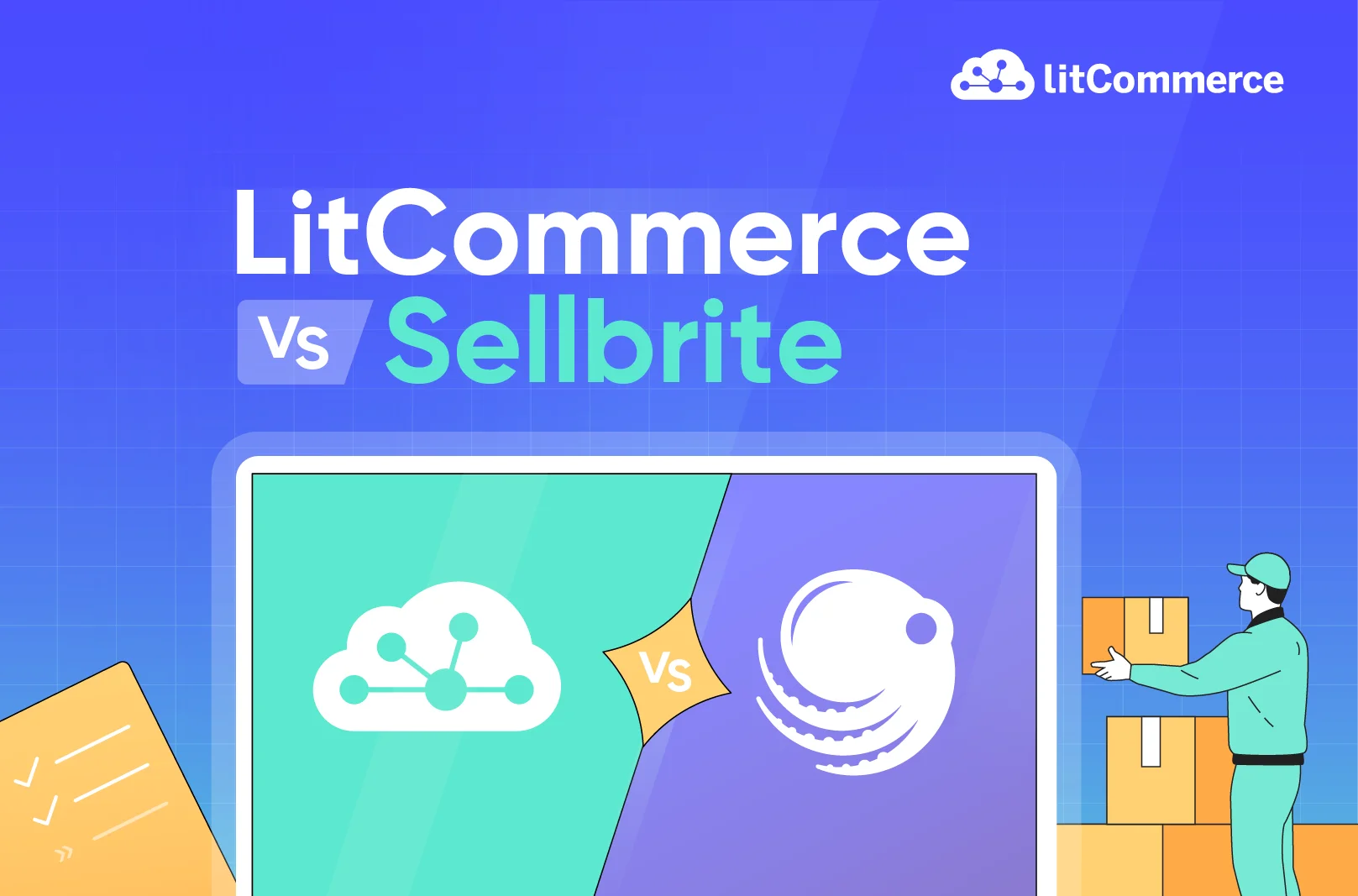LitCommerce vs Sellbrite are two popular multichannel selling tools, offering a range of features to help businesses sell on multiple platforms. In this comparison, we will thoroughly examine 7 factors to find their strengths and weaknesses.
- #1. Pricing
- #2. Channel supported
- #3. Ease of use
- #4. Listing Features
- #5. Inventory, Price & Order feature
- #6. Support system
- #7. Security and policy
Let’s dive in!
How We Compared LitCommerce and Sellbrite
To give you a fair and useful comparison, we followed a structured review process:
- Hands-on testing. We tried both tools to see how they work in real scenarios, focusing on listing products, syncing inventory, and managing multichannel sales.
- Feature evaluation. We assessed key features like ease of setup, integration options, automation, and pricing flexibility.
- User experience. We considered interface design, learning curve, and overall usability for small to medium-sized businesses.
- Support & resources. We reviewed available documentation, support channels, and customer feedback to understand reliability.
- Value for money. We compared pricing plans relative to features, scalability, and potential ROI.
This approach helps ensure our review is practical, unbiased, and relevant to online sellers looking for the right multichannel solution. Learn more about our methodology.
LitCommerce vs Sellbrite – Overview
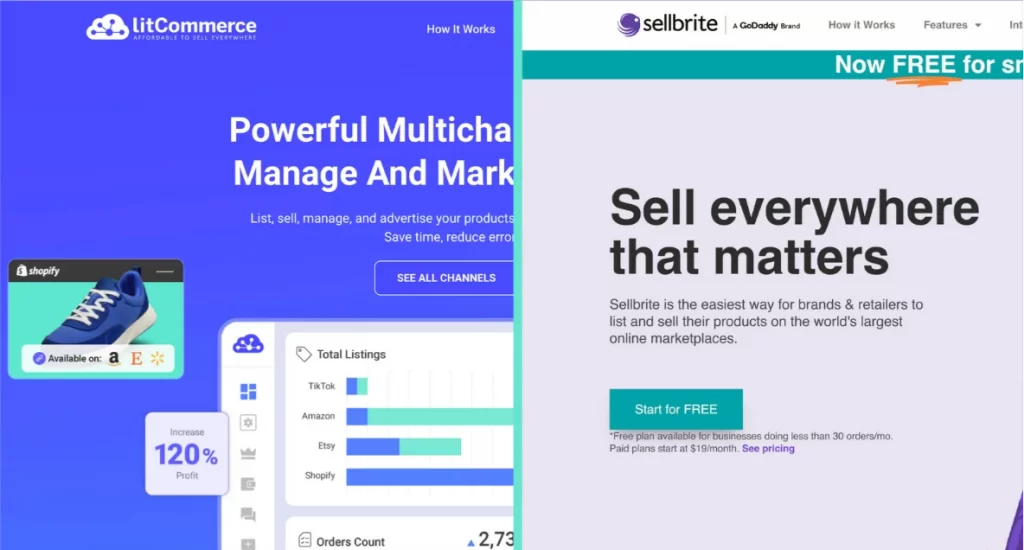
What is LitCommerce?
LitCommerce is probably an app you’ve heard of. Founded in 2020, it is a Vietnam-based, highly-rated multichannel selling tool (see their reviews on Trustpilot). They focus on powerful features while maintaining an intuitive and easy-to-use interface. The estimated monthly active users of LitCommerce are around 15,000.
On top of its multichannel listing capabilities, LitCommerce also offers a Product Feed Management Tool that helps sellers sync product data to top advertising channels like Google Shopping, Facebook, Pinterest, TikTok, and Bing.
Key features include smart category mapping, bulk feed rules, automated syncing, and built-in quality checks to ensure feeds meet each platform’s requirements. It’s designed for both beginners and advanced users who want to boost product visibility through paid and organic campaigns.
What is Sellbrite?
Sellbrite is a cloud-based multichannel eCommerce management platform that helps online sellers streamline their operations by centralizing product listings, inventory control, order processing, and fulfillment across multiple sales channels.
With Sellbrite, you can easily connect and manage your store on marketplaces like Amazon, eBay, Walmart, Etsy, and more—plus integrate with your own web store on platforms such as Shopify or WooCommerce.
The platform is designed to save time and reduce errors by keeping your inventory in sync across all channels in real-time. Any change you make, whether it’s updating stock levels, adjusting prices, or editing product details, is automatically updated everywhere you sell. It helps you avoid overselling and ensures your product data remains consistent across all channels.
Sellbrite consolidates all incoming orders into a single dashboard, allowing you to fulfill them from your own warehouse, through Amazon FBA, or using a third-party logistics provider, without needing to switch between accounts.
LitCommerce vs Sellbrite Comparison – 7 Factors to Consider
#1. Pricing
Let’s admit it. Pricing is one of the most important factors to consider for a multichannel selling tool. In the first part, we will help you find out whether these tools are worth paying for or not.
LitCommerce
About LitCommerce, they offer a range of pricing plans to cater to various business needs, starting at $29 per month for the Basic plan. They also provide a custom plan for businesses with unique requirements. And all these come with no setup costs.
- Monthly plans with 3 integrated channels:
LitCommerce's popular plans | Monthly | Annually (Save 20%) |
Up to 1,000 listings, unlimited order sync | $29 | $24.00/month |
Up to 2,000 listings, unlimited order sync | $44 | $36.00/month |
Up to 5,000 listings, unlimited order sync | $59 | $48.00/month |
Up to 10,000 listings, unlimited order sync | $84 | $68.00/month |
If you’re considering adding more channels, you can refer to the LitCommerce pricing page for detailed information.
Wondering if LitCommerce has a free trial? Yes, they do offer a 7-day FREE trial with full access to all features for new sellers.
Sellbrite
Meanwhile, Sellbrite offers 4 plans based on the number of orders:
Sellbrite's pricing plans | Monthly | Annually (Save 20%) |
Forever free (Up to 30 orders/month) | $0 | $0 |
PRO 100 (Up to 100 orders/month) | $29 | $24/month |
PRO 500 (Up to 500 orders/month) | $79 | $66/month |
PRO 2K (Up to 2,000 orders/month) | $179 | $149/month |
Note: An additional $19 will be added to the base monthly price ($16/month for the annual plan) if you choose to include Amazon FBA Integration.
Sellbrite for Shopify Pricing
Sellbrite also provides several pricing tiers for Shopify users, with no setup fees and a 14‑day trial:
- Forever Free Plan – $0/month, limited to 30 orders per month.
- Pro 100 – $19/month, up to 100 orders per month.
- Pro 500 – $59/month, up to 500 orders per month.
- Pro 2K – $99/month, up to 2,000 orders per month.
For sellers with over 2,000 monthly orders, Sellbrite offers custom high‑volume plans. Both LitCommerce and Sellbrite offer scalable pricing options, but with different approaches. Sellbrite’s pricing starts at $29/month for up to 100 orders and goes up to $399/month for unlimited orders and advanced features like phone support and priority assistance.
In contrast, LitCommerce offers a more flexible structure with unlimited orders & inventory sync included in all plans, starting from a comparable base price. Additionally, it provides priority support for all merchants with any paid subscription plans.
→ Verdict: While Sellbrite’s tiered model may suit merchants who prefer predictable pricing tied to order volume, LitCommerce’s pay-as-you-go design offers more adaptability—ideal for sellers with seasonal spikes or varying sales patterns.
#2. Channel supported
This is another of the most basic criteria to evaluate a multichannel selling app. If you are looking to sell on multiple channels, LitCommerce is a better choice.
LitCommerce
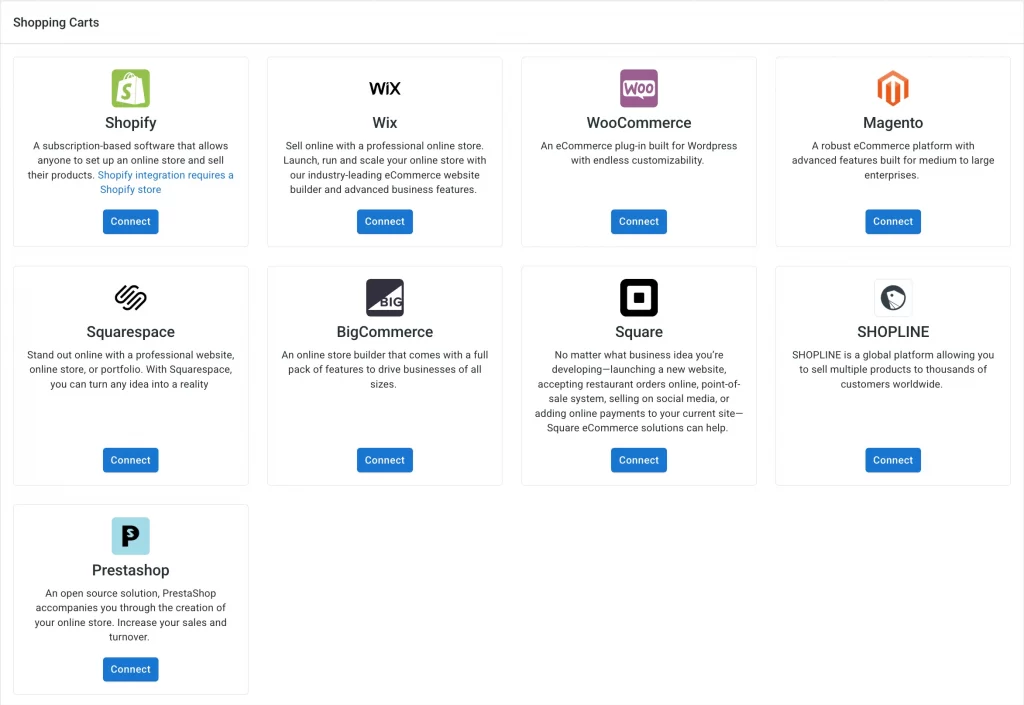
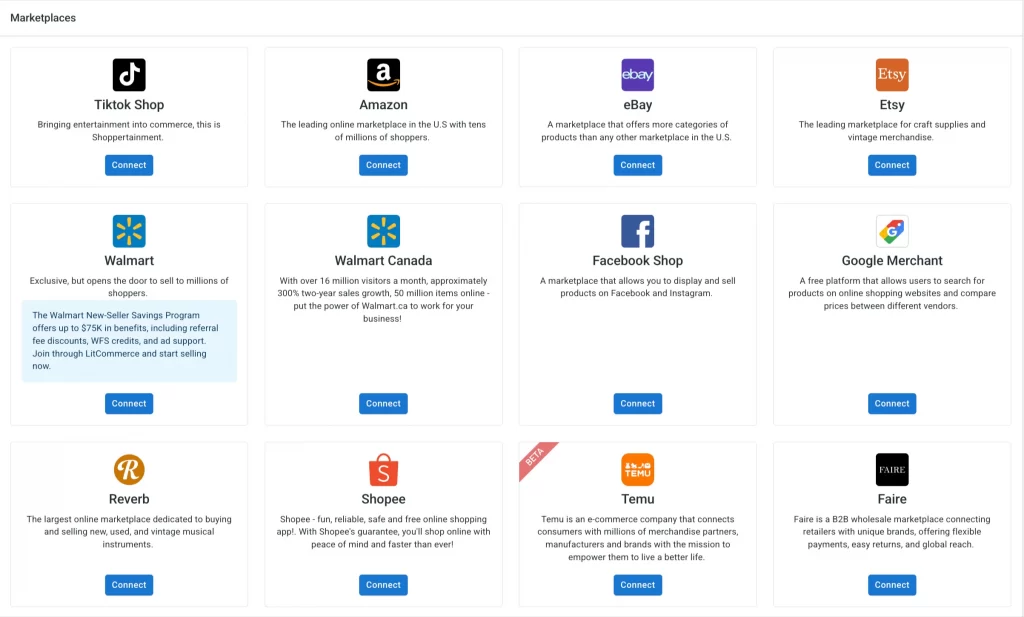
Their integrated pool includes 20+ eCommerce platforms and online marketplaces:
- Shopify
- Etsy
- eBay
- Amazon
- Tiktok
- Walmart
- Google Merchant
- Facebook Shop
- Reverb
- Shopee
- Wix
- BigCommerce
- WooCommerce
- Squarespace
- Shopline
- Prestashop
- Temu
- Faire
- Magento
- Shein
- Square
- File (CSV or Google Sheet)
Another point that makes LitCommerce stand out is the ability to integrate multiple channels at a time. Their users can sell on Etsy, Shopify, Amazon, and eBay with all inventory and orders synced to a single place.
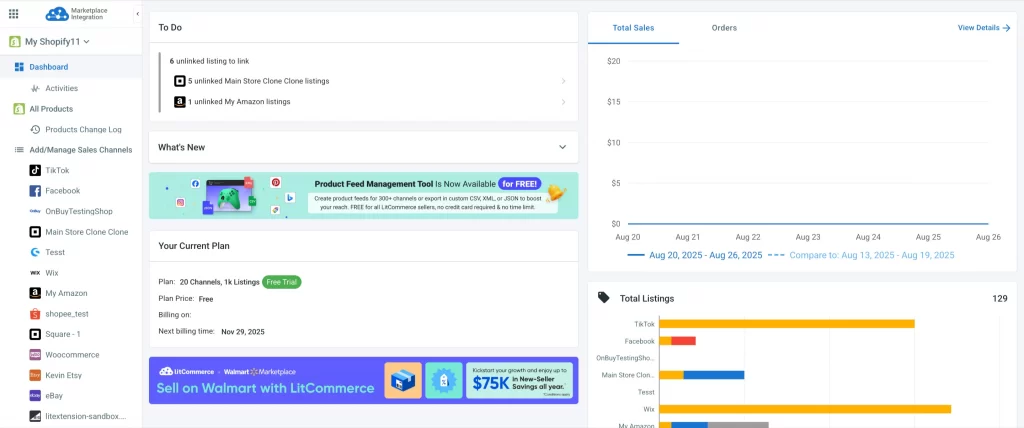
Sellbrite
In terms of Sellbrite, it allows connecting to the following marketplaces:
- Amazon
- eBay
- Etsy
- Walmart
- Google Shopping
- Sears
- Newegg
And Shopping Carts:
- Shopify
- Shopify Plus
- WooCommerce
- BigCommerce
Also, various integrations with shipping providers.
- USPS
- ShipStation
- Fulfillment by Amazon
- ShipEngine
- Flexport
- Skuvault
- Easyship
- SalesPad Cloud
- Inventory Source
- Algopix
What makes Sellbrite stand out is its integration with many shipping providers, which allows its users to print postage and fulfill multichannel orders right in its dashboard.
→ Verdict: We call it a tie this time. Each app has its own advantages. While LitCommerce provides wider channel integration and the ability to connect many platforms at once, Sellbrite has integrations with many shipping services, which is convenient for fulfillment.
#3. Ease of use
Well, this is a close one! LitCommerce and Sellbrite both do a pretty good job with their usability. Both have a modern, clean, and intuitive interface with minimal complications.
LitCommerce
From the LitCommerce dashboard, you can follow the starter guide, find suitable cases, and take action right away. Besides, LitCommerce always shows a quick guide video when you don’t know where or how to start.
Even better, LitCommerce uses simple language and marketplace-customized terms, so if you’re already familiar with selling on marketplaces, you don’t need to learn new app terminology. This clean, informative, and familiar interface makes the experience smooth for both newbies and seasoned sellers.
On the main dashboard, a clear to-do list guides you through the next steps, so you always know what to work on. This clean, informative, and well-structured interface makes the experience smooth for both newbies and seasoned sellers.
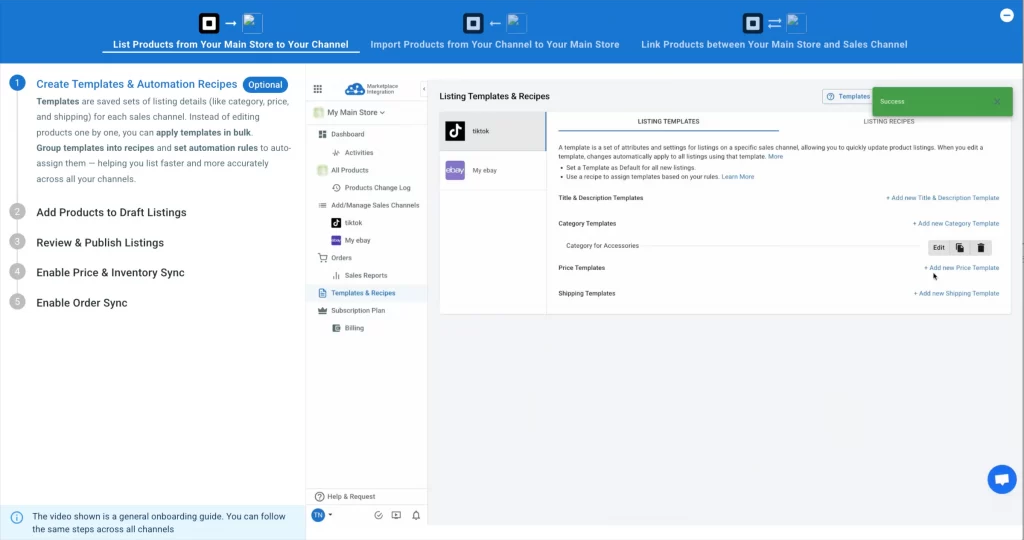
Sellbrite
At first glance, Sellbrite’s interface is quite user-friendly. It also comes with in-app guides (which appear on the bottom right corner when you jump into the main dashboard), and sample products for you to try listing. All items are neatly organized and easy to navigate.
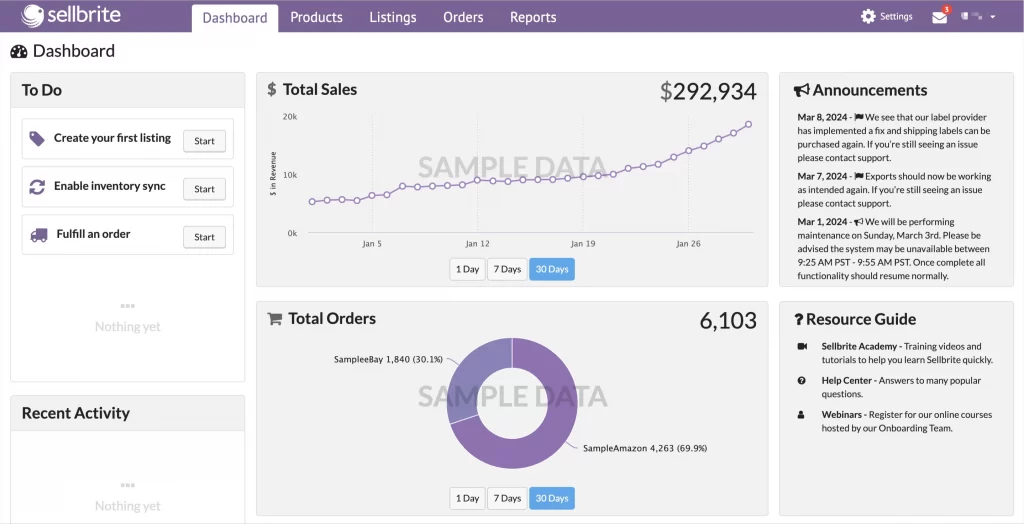
→ Verdict: Both LitCommerce and Sellbrite are very easy to use, offering modern UI/UX, clear navigation, and helpful guides to get you started. Each tool provides a well-structured dashboard and step-by-step instructions so that you can set things up without confusion.
#4. Listing Features
When it comes to listing products on multiple marketplaces, both Sellbrite and LitCommerce make the process smooth and stress-free.
LitCommerce
LitCommerce gives you bulk listing power but adds extra flexibility. You can edit more product information directly within LitCommerce. It’s free and powerful listing editor lets you update titles, descriptions, prices, quantities, and more all in bulk, on a single screen.
Combined with templates and recipes, this makes it easy to standardize and speed up your listings. You can import products, link them via SKUs, edit in bulk, and publish to multiple marketplaces without missing a step. It also syncs prices, inventory, and listings in near real time, or on a schedule you choose.
LitCommerce also offers auto-mapping category. This feature is available on both tools. The Auto-mapping template ensures your product will be categorized correctly in the channel you are listing, saving you a significant amount of time.

Sellbrite
Listing management is one of Sellbrite’s key strengths. Instead of logging into each marketplace separately, you can create and update listings for Amazon, eBay, Walmart, Etsy, and Shopify all from one dashboard.
Sellbrite also supports bulk editing, templates, and category mapping, making it easy to meet marketplace requirements and keep listings consistent. Since listings are tied to your inventory, stock levels update automatically across every channel, helping you avoid overselling.
Best of all, any change you make, like updating a price or description syncs everywhere instantly, saving time and reducing errors.
→ Verdict: In short, Sellbrite focuses on fast, straightforward listing at scale, while LitCommerce adds more structure, editing power, and customization for sellers who want a bit more control over every detail.
#5. Inventory, price & order feature
Both LitCommerce and Sellbrite make it easy to keep your inventory, prices, and orders in sync across multiple sales channels, reducing the risk of overselling and saving you hours of manual updates.
LitCommerce
The Inventory, Price & Order Sync feature in LitCommerce keeps your products, prices, and orders consistent across every sales channel. LitCommerce has confirmed that the sync frequency is 15 minutes.
#1. Inventory sync
The tool keeps your stock levels updated in real time across all connected marketplaces. You can set advanced but simple rules — such as showing only a percentage of total stock, fixing quantities, or applying min/max thresholds. Each marketplace can have its own settings, using terms familiar to sellers, so you can fine-tune inventory without confusion.

#2. Price sync
Its Price Sync lets you automatically adjust prices per channel based on your main store catalog. You can increase or decrease prices by a fixed amount or percentage and even round prices up or down — perfect for handling different fee structures on platforms like eBay, Amazon, or Etsy.
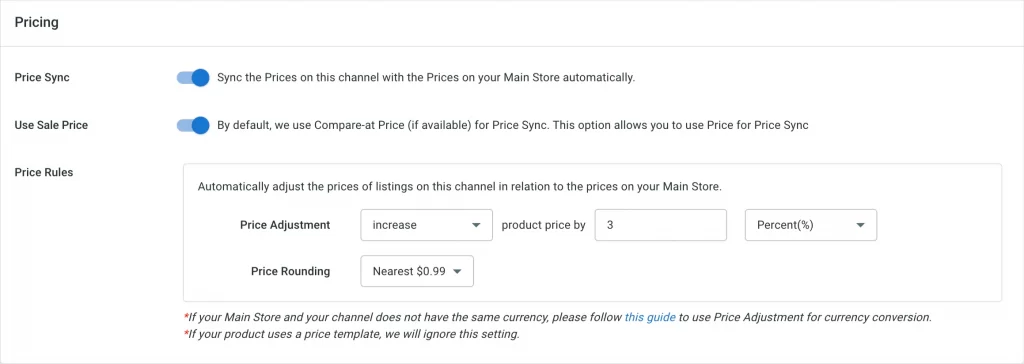
#3. Order sync
All marketplace orders are pulled into your main store for centralized management, and users can get the added benefit of syncing orders with multiple warehouse locations.

Sellbrite
In contrast, Sellbrite also offers centralized inventory management with easy monitoring of available, reserved, and on-hand stock across warehouses.
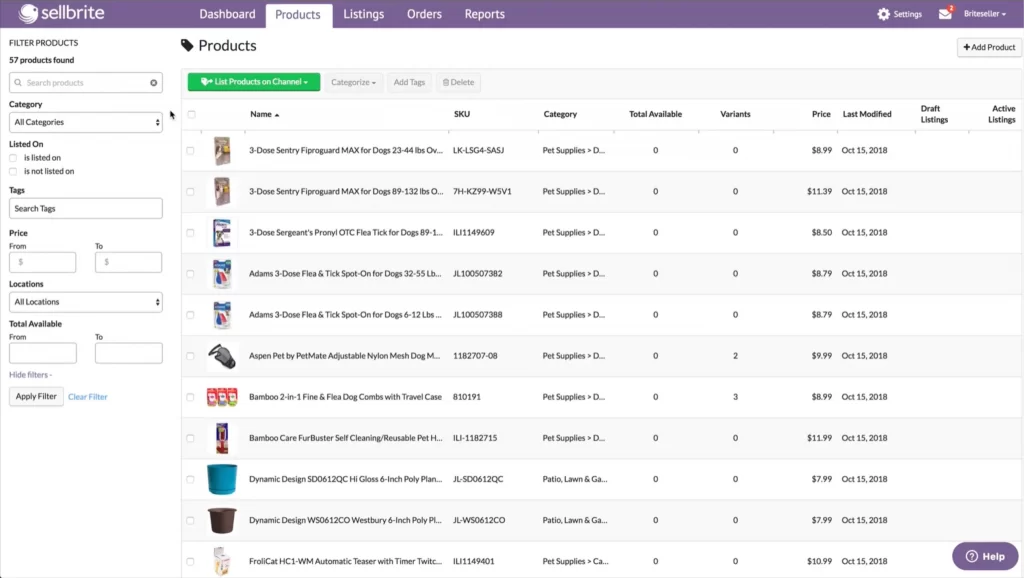
#1. Inventory sync
Sellbrite centralizes inventory management by showing available, reserved, and in-hand stock levels for every marketplace in one place. Any change from a sale, restock, or manual update is synced in real time across all channels, preventing overselling and stock-outs. With bulk editing, you can also update inventory for multiple products at once.
#2. Price sync
You can set and manage prices from a single system, and Sellbrite automatically pushes those updates to every connected marketplace like Amazon, eBay, or Walmart. This near real-time sync makes it easier to stay competitive, letting you adjust pricing quickly without logging into each platform individually.
#3. Order sync
All orders from every sales channel flow into Sellbrite’s unified order dashboard, where you can process them from one interface. Orders can be automatically routed to Amazon FBA, dropshippers, or other fulfillment locations, with efficient processing tools that speed up shipping and reduce errors. Customers also receive timely status updates while sellers can track progress with ease.
When it comes to sync speed, both tools offer a 15-minute frequency for inventory and price updates on paid plans. Sellbrite’s free plan syncs every 2 hours, while LitCommerce keeps the 15-minute interval for all paid tiers. Keep in mind that while both publish updates instantly, marketplaces like Amazon or Etsy may take extra time to process them on their end.
→ Verdict: If you want to manage all orders directly from your eCommerce platform, LitCommerce may feel more natural. LitCommerce is best if you want your main store to remain the central hub for control. Sellbrite is better if you want a standalone system with more powerful bulk editing, fulfillment routing, and centralized dashboards.
#6. Support system
Both LitCommerce and Sellbrite provides dedicated customer support.
LitCommerce
LitCommerce supports its users via 4 ways:
- Usage Doc
- LitCommerce Academy
- Live chat
LitCommerce Customer Support team is available at the following time: (Monday) from 04:00 AM to 24:00 (GMT +7), (Tuesday – Saturday) 24/7 GMT+7, Sunday from 08:00 – 24:00 GMT+7.
Overall, LitCommerce’s customer services are highly rated on review platforms and eCommerce App Stores and markets.
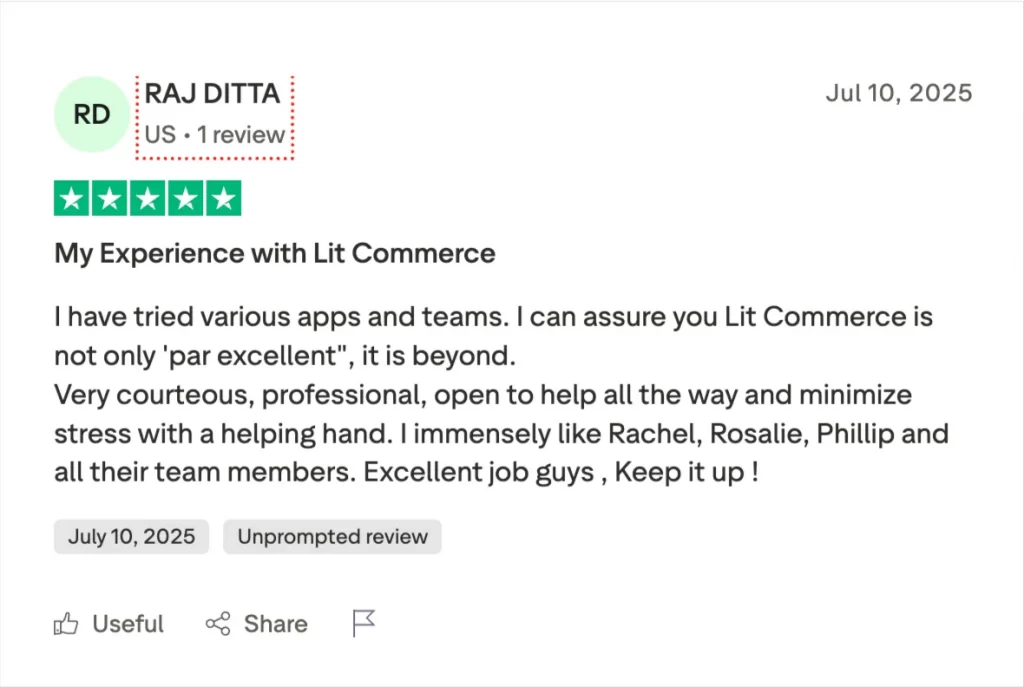
Sellbrite
Sellbrite’s customer service is available from Monday to Friday, 7 AM to 4 PM PST. You can contact their support team by submitting a ticket inquiry using the purple question mark icon while logged in.
Additionally, you can seek support by texting Sellbrite at 1(844) 977-0717. The support team observes specific holidays when the office is closed. , The companyand responses to messages received during these holidays will be addressed on the next business day after the holiday. The observed holidays include New Year’s Day, MLK Jr. Day, Memorial Day, Juneteenth, Independence Day, Labor Day, Thanksgiving Day, Day After Thanksgiving, and Christmas Day.
While Sellbrite receives decent support ratings, some users on platforms like G2 and Shopify App Store have mentioned delays in response time and challenges in resolving issues that involve third-party integrations.
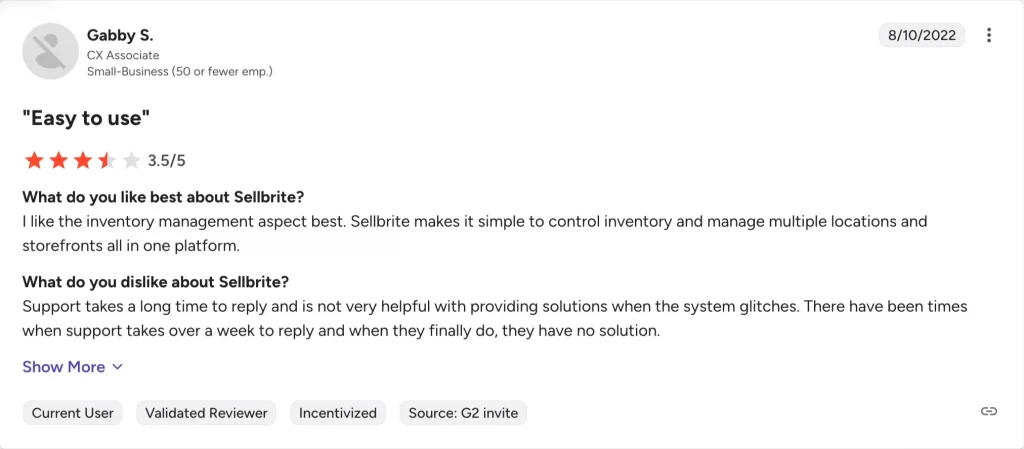

→ Verdict: LitCommerce provides broader support with multiple channels, near 24/7 availability, and strong customer feedback, making it more accessible. Sellbrite’s support is reliable but limited to weekdays and has occasional delays, giving LitCommerce the edge.
#7. Security and policy
Based on the provided references, both LitCommerce and Sellbrite appear to take data security seriously. Here’s a breakdown of their security practices:
LitCommerce:
- Privacy Policy: Clearly outlines the types of data collected, how it’s used, and with whom it’s shared.
- GDPR Compliance: Dedicated page outlining their compliance with the General Data Protection Regulation (GDPR) for users in the European Economic Area (EEA).
- Data Security Policy: Details their security measures, including data encryption, access controls, and incident response procedures.
Sellbrite:
- Data Processing Addendum: A legal document outlining data processing practices and responsibilities, often required under GDPR compliance.
- Privacy Policy: Similar to LitCommerce’s policy, it details data collection, use, and sharing practices.
→ Verdict: Both LitCommerce and Selbrite employ data encryption at rest and in transit, a standard security practice for protecting sensitive information. They also established access controls to restrict unauthorized access to user data and provide incident response procedures for handling data breaches or security incidents.
LitCommerce vs Sellbrite – FAQs
LitCommerce is a powerful multichannel listing tool with automatic inventory/price sync, templates, and recipes, managing inventory directly on your eCommerce platform; meanwhile, Sellbrite focuses on inventory management and fulfillment within its own system, requiring all edits to be made in Sellbrite. Yes, both LitCommerce and Sellbrite offers integrations with popular eCommerce platforms like Shopify and WooCommerce, and many marketplaces such as Amazon and eBay. LitCommerce offers pay-as-you-go pricing plans based on the exact number of channels and listings that you need. Meanwhile, Sellbrite’s pricing is based on the tier of orders (100/200/5000 orders). Businesses can choose a plan that best fits their needs and budget.
So, The Decision Depends on You!
After extensively testing LitCommerce and Sellbrite, it’s clear that both tools offer powerful multichannel listing solutions. LitCommerce excels in multichannel connectivity, making it a great choice for online retailers who want to sell on multiple channels directly from their web store dashboard. On the other hand, Sellbrite specializes in inventory and order management capabilities right in its own dashboard.
Ultimately, the choice between LitCommerce and Sellbrite depends on your specific business needs, budget, and platforms. Consider factors such as the size of your inventory, the number of sales channels you operate on, and the level of integration you require.
Both LitCommerce and Sellbrite have proven to be reliable tools that can help streamline your eCommerce operations and boost your business success — but if you want more flexibility, marketplace-specific features, and the ability to manage everything from your eCommerce platform, LitCommerce might just be the smarter pick.

